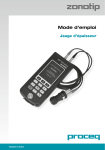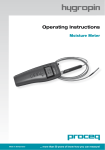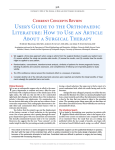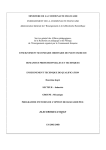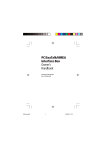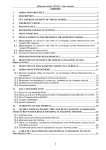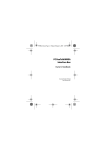Download Operating Instructions
Transcript
Operating Instructions Thickness Gauge Made in Switzerland Table of contents 1. Safety and Liability 3 2. Tutorial 4 3. Getting Started 3.1 Overview 3.2 Connect Probes 3.3 Overview Keypad 3.4 First Steps before Measuring 5 5 6 6 7 4. Use of the Instrument 4.1 The Different Measuring Modes 4.1.1 Overview of Settings / Menu Structures 4.1.2 Norm Mode 4.1.3 Memory Mode 4.1.4 A-Scan Mode 4.2 Pictograms 4.2.1 Signal Strength Indicators and Measurement Method 4.2.2 Operation Pictograms A-Scan 4.3 Setup-Screen 4.3.1 Create a New Material / Edit a Material 4.3.2 Calibration on known Material / Determinate the US velocity 4.3.3 Overview of Different Setup-Items 8 8 8 10 11 12 13 13 14 14 14 15 15 5. Velocity of Longitudinal Ultrasonic Waves 16 6. Zonolink 16 7. Technical Specifications 18 8. Part Numbers and Accessories 19 9. Maintenance and Support 19 2 © 2014 Proceq SA 1. Safety and Liability 1.1 Safety and Usage Precautions This manual contains important information on the safety, use and maintenance of the Zonotip / Zonotip+. Read through the manual carefully before the first use of the instrument. Keep the manual in a safe place for future reference. 1.2 Liability and Warranty Proceq’s “General Terms and Conditions of Sale and Delivery” apply in all cases. Warranty and liability claims arising from personal injury and damage to property cannot be upheld if they are due to one or more of the following causes: • Failure to use the instrument in accordance with its designated use as described in this manual. • Incorrect performance check for operation and maintenance of the instrument and its components. • Failure to adhere to the sections of the manual dealing with the performance check, operation and maintenance of the instrument and its components. • Unauthorized structural modifications to the instrument and its components. • Serious damage resulting from the effects of foreign bodies, accidents, vandalism and force majeure. All information contained in this documentation is presented in good faith and believed to be correct. Proceq SA makes no warranties and excludes all liability as to the completeness and/or accuracy of the information. 1.3 Safety Instructions The instrument is not allowed to be operated by children or anyone under the influence of alcohol, drugs or pharmaceutical preparations. Anyone who is not familiar with this manual must be supervised when using the instrument. 1.4 Correct Usage • The instrument is only to be used for its designated purpose as describe herein. • Replace faulty components only with original replacement parts from Proceq. • Accessories should only be installed or connected to the instrument if they are expressly authorized by Proceq. If other accessories are installed or connected to the instrument then Proceq will accept no liability and the product guarantee is forfeit. © 2014 Proceq SA 3 2. Tutorial The Zonotip / Zonotip+ is designed to measure the thicknesses of ferrous and non-ferrous metals as well as products made of plastics and other materials with a low ultrasonic attenuation. It measures the double traverse of an ultrasonic pulse through the object under test from one surface to the other (see figure 1). This value is then converted into the product thickness value. Thickness h = c ⋅ t0 , c: speed of sound 2 Transducer n x t0 2 x t0 t0 h Object under test E1 E2 E1 E2 En t Figure 1: Determining the thickness of an object by means of ultrasound pulse echo technique The probe has a sharp radiation directivity and ultrasound receiving pattern, therefore, the product thickness is determined directly under the converter installation place. If the material surface opposite to the one on which the probe is installed, has cavities, the US pulses will be reflected from them, and the thickness is determined as the shortest distance from the external surface to these cavities. The Zonolink Software, included in the package, allows downloading the data measured by the Zonotip / Zonotip+ using any PC. Communication with the computer is provided through a USB port. Practical Advice for Measuring To receive the maximal measurement accuracy, make sure that the probe, the calibration sample and the test object have roughly the same temperature. If the measured velocity of the material differs from the actual velocity, revise the velocity manually or perform a calibration. The measurement accuracy directly depends on the accuracy of the velocity setting. For a precise measurement, take a sample of the same material as the test object and set the velocity according to it. For this procedure, use the same US converter as for the actual measurement. If possible, use a plane-parallel sample with smooth surface for the test measurement. 4 © 2014 Proceq SA 3. Getting Started 3.1 Overview Ports for transducers Functional keys Navigation keys Zeroing sample / test plate USB Port Figure 2: The Zonotip instrument Figure 3: Connection of the 4.0 MHz transducer. Make sure the red cable is connected to the port with the red dot. © 2014 Proceq SA Figure 4: Connection of the 2.5 MHz transducer 5 3.2 Connect Probes The Zonotip is available with two different transducers: The standard 4.0 MHz dual-element transducer is meant for most measurements (see figure 5). It requires two cables, one for the outgoing signal, one for the incoming. The optional 2.5 MHz single-element integrated transducer is smaller and requires only one cable (see figure 6). This makes it more convenient to use in smaller areas or in areas that are harder to access. The 2.5 MHz is included when purchasing the Zonotip+ unit. It is also available separately. Figure 5: 4.0 MHz transducer (D1771) Figure 6: 2.5 MHz transducer (S3567) 3.3 Overview Keypad 6 ON / OFF Turn the instrument “on” or “off”. Functional Key Carry out various actions depending on the settings. The respective operation is displayed above each of the keys. Measurement Mode / Setup Screen Switch between the measurement modes and the setup screen. Enter Confirm a selection. Left / Right Navigate through the menu. Up / Down Navigate through the menu. Plus / Minus Select and change active parameters. © 2014 Proceq SA 3.4 First steps before measuring After connecting the desired probe, turn on the instrument. Click to enter the setup screen (see figure 7). Figure 7: Setup-Screen • Select the desired mode - Norm, Memory, A-Scan (Zonotip+ only). The different modes are explained in chapter 4.1. • Select the probe which you have connected. A text will appear on the screen. Please follow these instructions. This process is needed to calibrate the instrument before the first measurement. • Please put a little coupling paste onto the built-in zeroing sample (test plate) of the Zonotip (see figure 2). The thickness of the zeroing sample is 5 mm. • Select the material you are about to test. © 2014 Proceq SA 7 4. Use of the Instrument 4.1 The Different Measuring Modes 4.1.1 Overview of Settings / Menu Structures The Zonotip / Zonotip+ features different measuring modes that can be set in the Setup-Screen: the Norm mode, the Memory mode and the A-Scan mode (Zonotip+ only). Measuring Mode Memory Norm A-Scan Mode 1 Mode 1 Mode 1 Probe 2 Probe 2 Probe 2 Material 3 Material 3 Material 3 Calibrating on 4 Calibrating on 4 Calibrating on 4 Monitor 5 Monitor 5 Discrete 8 Limit: beginning 6 Limit: beginning 6 Scan beginning 15 Limit: end 7 Limit: end 7 Scan end Discrete 8 Discrete 8 Gate: beginning 17 Sound 9 Clear Memory 16 14 Gate: end 18 9 Gain 19 20 Vibration 10 Sound Language 11 Vibration 10 A-Scan type Measuring units 12 Language 11 Sound Brightness Measuring units 12 Vibration 10 Brightness Language 11 13 13 9 Measuring units 12 Brightness13 8 © 2014 Proceq SA All Modes Norm Mode 1 Memory A-Scan Test Probe 2 Material 3 Calibrating on 4 Monitor 5 Open D1771 4.0 MHz S3567 2.5 MHz Open New, Aluminium, Gold, Brass, Copper, Ice, Polyethylene, Lead, Silver, Steel, Plexiglass, Glass, Titan Run for details see 4.3.2 Edit Inside Off Outside Limit: beginning 6 Edit for details see 4.3.2 Limit: end 7 Edit for details see 4.3.2 Discrete 8 0.1 Select the number of decimals Sound 9 Vibration 10 0.01 On Off On Off English German to change the language, please press the functional keys multiple times. French Language 11 Italian Portuguese Spanish Chinese Russian Measuring units 12 Brightness 13 © 2014 Proceq SA mm inch + - 9 Memory Clear Memory 14 Run The % amount represents the used memory capacity A-Scan Scan beginning 15 Edit for details see 4.3.2 Scan end 16 Edit for details see 4.3.2 Gate: beginning 17 Edit for details see 4.3.2 Gate: end 18 Edit for details see 4.3.2 Gain 19 Edit for details see 4.3.2 A-Scan type 20 Filled Empty 4.1.2 Norm Mode Using the Norm mode is convenient when the measurement results do not have to be recorded. This mode enables the Zonotip to promptly determine the thickness of the test object and to set the “monitor” (5) response range. If “monitor” (5) is set to “inside” and the readings are within the defined limits, the readings are shown in red. If “monitor” is set to “outside” and the readings are within the defined limits, the readings are shown in white. 10 1. Active bookmark of Norm mode 2. Battery charge indicator 3. Measurement units 4. Measurement results 5. Indicator of the measurement taking method (see chapter 4.2.1) 6. Indicator of the signal level (see chapter 4.2.1) 7. Current Probe 8. Lower limit 9. Upper limit 10. Current material 11. US waves velocity in the current material © 2014 Proceq SA 4.1.3 Memory Mode The Memory mode of the Zonotip / Zonotip+ allows to promptly determine the thickness of the test object, to record the measurement in the memory of the instrument, to browse them on the display as well as to correct the entries and to conduct re-measurements. The screen is divided into two parts: the upper part displays information about the measurement, the lower part shows information about previously saved results. Up to 500 cells (single measurements) can be stored in up to 100 groups. If the maximum number of cells in a group is reached, a related information caption will appear on the instrument screen. To store a measurement, please press . 1. Active bookmark of the Memory mode 2. Battery charge indicator 3. Measurement units 4. Measurement result 5. Indicator of the measurement taking method (see chapter 4.2.1) 6. Indicator of the signal level (see chapter 4.2.1) 7. Number of group 8. Number of measurement 9. Stored measurement results Editing Stored Measurements 1. Press the 2. Use the keys to 3. Press the 4. By pressing 5. Press key to enter the edit mode. The screen will show . to select the measurement that needs to be overwritten. key to start a new measurement. , the measured data will be stored (the old data will be overwritten). to exit the edit mode. Transferring data Please note that device needs to be in Memory Mode in order to communicate with PC, refer to section 6. Zonolink © 2014 Proceq SA 11 4.1.4 A-Scan Mode (Zonotip+ only) The A-Scan mode allows excluding measurement inaccuracies, caused by e.g. flaws or cracks in the test object. The signal is visualized on the display as an A-Scan, which allows a more indepth analysis of the reading. The A-Scan mode features the following measurement options: • thickness of a test object even if it contains flaws or cracks • general flaw and crack detection • bond quality of layered materials, including delamination detection • thickness of layered materials It is also possible to zoom in on an arbitrary location of the A-Scan in order to interpret the measurements better. Furthermore, the horizontal and vertical position as well as the length of the gate (red horizontal bar) can be adjusted. The gate feature is especially useful for situations where several echos appear in the A-Scan. Therefore, the gate must be moved to the echo that needs to be evaluated. The screen is divided into two parts: the upper part shows the signal, the lower part displays the numerical values of the parameters and the operation pictograms (see chapter 4.2.2). The results of the A-Scan measurement are saved at the end of the last used measurement group. The latter is created in the Memory mode (see chapter 4.1.3). To view the saved A-Scans, switch to the Memory mode. The saved A-Scans have the symbol to the left of the test results. i 12 When returning to the A-Scan mode, the graphic image of the A-Scan will be lost. 1. Active bookmark of A-Scan mode 2. Battery charge indicator 3. Measurement units 4. Measurement results 5. A-Scan signal 6. Gate 7. Scan beginning 8. Scan end 9. Gain 10. Operation pictograms (see chapter 4.2.2) © 2014 Proceq SA Using the Keys in the Active mode Operation Pictogram Key Purpose Change of gate length Vertical position of the gate Horizontal position of the gate Zoom in on the A-Scan Set the signal gain in decibel Horizontal scrolling of the signal on the screen Set the signal gain in decibel 4.2 Pictograms 4.2.1 Signal Strength Indicators and Measurement Method (Norm Mode and Memory Mode only) Signal level is maximal Signal level is average Signal level is minimal No signal No measurements Measurement using the ACF method (see chapter 4.2.2) Measurement using the threshold method (see chapter 4.2.2) Overwrite mode (see chapter 4.1.3) © 2014 Proceq SA 13 4.2.2 Operation Pictograms A-Scan (Zonotip+ only) Change gate parameters Select signal section to be displayed Selection of the measurement method: the instant the signal within the gate exceeds the threshold (vertical position of the gate) is used for the measurement. Selection of the measurement method: the distance between the peaks of two signals within the gate is used for the measurement. Selection of the measurement method: the peak of the signal within the gate is used for the measurement. Selection of the measurement method: Auto Correlation Function (ACF) is applied to the signals within the gate. 4.3 Setup-Screen 4.3.1 Create a New Material / Edit a Material (Applicable for all Modes) The Zonotip / Zonotip+ can store up to 64 different materials. Enter the “Material” menu to create or edit a new material. Select “Create” or “Edit” on the screen. Use the keys to scroll in the table of symbols (“1”). Press the key to choose a symbol. Use the keys to edit the lines (“2” and “3”). To jump from the left to the right box (from “2” to “3”), position the cursor on the first position of the left box and press the key. 14 © 2014 Proceq SA 4.3.2 Calibration on known Material / Determinate the US velocity To determine the velocity of an US wave in a material with a known thickness, use the “Calibrating on” function in the setup screen. Enter the thickness of the sample with “Edit” and start the calibration process by pressing “Run”. The sample thickness should be within 2.0 - 80.0mm (0.078 - 3.15 inch). Once the data acquisition is finished, the velocity and material can be saved and added to the database of the instrument (see 4.3.1.). 4.3.3 Overview of Different Setup-Items Calibration On 4 All Modes Designed for determining the velocity of an US wave in a material with a known thickness 2.0 - 80.0 mm (0.078 - 3.15 inch) Monitor 5 All Modes Set response conditions for color, sound or vibration alarm • Inside: results are within the set interval • Outside: results are not in the set interval • Off: monitor is switched off Limit: beginning 6 All Modes Set the lower limit of the “monitor” 0 - 150 mm (0 - 5.9 inch) Limit: end 7 All Modes Set the upper limit of the “monitor” 1 - 300 mm (0 - 11.8 inch) Clear Memory 14 Memory Erasing the measurement results Scan beginning 15 A-Scan Set the beginning of the reflection area on the screen 0 - 150 mm (0-5.9 inch) Scan end 16 A-Scan Set the end of the reflection area on the screen 5 - 300 mm (0.2 - 11.8 inch) Gate: beginning 17 A-Scan Set lower limit 0 - 150 mm (0 -5.9 inch) Gate: end 18 A-Scan Set upper limit 1 - 300 mm (0 - 11.8 inch) Gain 19 A-Scan Set the amplification of the instrument inlet path 0 - 80 dB Type of A-Scan 20 A-Scan Selection of the signal reflection type • Fill: reflected in the filled type • Outline: reflected in form of an outline © 2014 Proceq SA 15 5. Velocity of Longitudinal Ultrasonic Waves Material Velocity [m/s] Material Velocity [m/s] Material Velocity [m/s] Chrome 6845 Copper 4700 Concretes 2000 - 5400 Zinc 4170 Molybdenum 6290 Gabbro 38 6320 Basalt 5930 Aluminum 6260 Plaster stone 4790 Vanadium 6000 Ebonite 2400 Foliated granite 7870 Bismuth 2180 Osmium 5478 Granite 4450 Tungsten 5460 (Phosphor) bronze 3530 Diabase 85 5800 Iron 5850 Limestone 6130 Dolomite 4450 Gold 3240 Ceramized glass 6740 Fused quartz 5930 Constantan 5240 Steel 20 6060 Plexiglas 2670 Brass 4430 Steel 15 5400 Polystyrene 2350 Capron 2640 Steel 40 5600 Rubber 1480 Ice 3980 Steel 70 5960 Mica 7760 Manganine 4660 Steel 35 5680 Organic glass 2550 Marble 6150 Tantalum 4235 Silicate glass 5500 Silver 3600 Manganese 5561 Teflon 1350 Lead 2160 Magnesium 5790 Steel St3 5930 Tin 3320 Cast iron 3500 - 5600 Textolite 2920 Nickel 5630 Labradorite 44 5450 Porcelain 5340 6. Zonolink Control Panel If this icon is in color - there is a connection to the instrument. If this icon is in greyscale - there is no connection to the instrument. If there is a connection, the process of data receiving from the instrument can be launched. saving the data to the PC. request the online help. request the information about the application. Loading the data • Turn on the thickness gauge. • Set the device to Memory Mode. • Connect the thickness gauge to the PC using a USB cable. • Press the button (in color). i 16 Please note that the device is in the Memory Mode; otherwise the device will not connect to the PC, enabling you to transfer your data. © 2014 Proceq SA • The process of data receiving will be launched. • If the data is transferred successfully, the message “The data from the instrument was fully received” will appear, and the data will be displayed.  Saving of the received data on the PC • Press the button . • In the window «Save as» name the file and indicate the path for saving. By default, the software will save the data to the folder where the application is installed. However, the user can select any folder to save the data in. The default name of the file will have the format «resultsX», where X is an index number. The index number is generated automatically from the numbers that are missing in the selected folder. For instance, if there are files «results25» and «results27» in the folder, the software will advice to save the file with the name «results26». However, the user can set any name for the data file. The software will save the files in the *.csv format, which can then be opened in programs such as Excel or Notepad.  Shutdown Press the button  If the changes were not saved, the software will warn about that.  © 2014 Proceq SA 17 To save the data, press «Yes». The software will open the window for data saving. To exit the software without saving the changes press «No». To return to the application press «Cancel». 7. Technical Specifications Instrument Operating temperature -20 °C to 50 °C (-4 °F to 122 °F) Humidity up to 85% RH with a temperature of 25 °C (77 °F) Battery operation period 9h Power built-in LiPol accumulator Operation supply voltage 3.7 V Dimension 157 x 70x 23 mm (6.1 x 2.7 x 0.9 inch) Weight 250 g Display type TFT Permissible surface roughness Rz160 / N12 / Ra = 50 µm Minimum curvature radius 10 mm (0.4 inch) Ultrasonic velocity range from 1000 to 9999 m/s Data memory 100 groups each max. 500 measurements Interface type USB Thickness resolution IP Classification < 99.99 mm: 0.01 mm > 100.0 mm: 0.1 mm IP52 Transducer Type Dual-element Single-element Frequency 4.0 MHz 2.5 MHz Measurement range (steel) 0.7 - 300 mm 0.7 - 300 mm Diameter of ultrasonic element 16 mm (0.6 inch) 10 mm (0.4 inch) Connector type LEMO type 00.250 LEMO type 00.250 45 x ∅23 mm (1.8 x ∅0.9 inch) 24 x ∅16 mm (0.9 x ∅0.6 inch) (∅18.5 at the connector) 23 g 16 g Size Weight Standards and Regulations Applied • ASTM E 797 • EN 15317 18 © 2014 Proceq SA 8. Part Numbers and Accessories 8.1 Units Part No. Description 790 10 000 Zonotip unit consisting of: Indicating device with calibration sample, transducer 4.0 MHz, transducer cable 2pol 1.2 m, couplant, battery charger with USB cable, carrying strap, data carrier with software, documentation, protective pouch, carrying case 790 20 000 Zonotip+ unit consisting of: Indicating device with calibration sample, transducer 4.0 MHz, transducer cable 2pol 1.2 m, transducer 2.5 MHz, transducer cable 1pol 1.2 m, couplant, battery charger with USB cable, carrying strap, data carrier with software, documentation, protective pouch, carring case 8.2 Parts and Accessories 790 11 001 D1771 Ultrasonic Transducer 4.0 MHz 790 12 001 S3567 Ultrasonic Transducer 2.5 MHz 710 10 031 Ultrasound couplant, 250 ml 790 80 001 Step Test Block (inches) 790 80 002 Step Test Block (mm) 9. Maintenance and Support 9.1 Support Concept Proceq is committed to providing a complete support service for this instrument. It is recommended that the user registers the product on the www.proceq.com to obtain valuable information on available updates and other useful information. 9.2 Standard Warranty and Extended Warranty The standard warranty covers the electronic portion of the instrument for 24 month and the mechanical portion of the instrument for 6 month. An extended warranty for one, two or three years for the electronic portion of the instrument may be purchased up to 90 days of purchase. © 2014 Proceq SA 19 Proceq Europe Ringstrasse 2 CH-8603 Schwerzenbach Phone +41-43-355 38 00 Fax +41-43-355 38 12 [email protected] Proceq UK Ltd. Bedford i-lab, Priory Business Park Stannard Way Bedford MK44 3RZ United Kingdom Phone +44-12-3483-4515 [email protected] Proceq USA, Inc. 117 Corporation Drive Aliquippa, PA 15001 Phone+1-724-512-0330 Fax+1-724-512-0331 [email protected] Proceq Asia Pte Ltd 12 New Industrial Road #02-02A Morningstar Centre Singapore 536202 Phone+65-6382-3966 Fax+65-6382-3307 [email protected] Proceq Rus LLC Ul.Optikov 4 korp.2, lit. A, Office 410 197374 St. Petersburg Russia Phone/Fax + 7 812 448 35 00 [email protected] Proceq Middle East P. O. Box: 8365 SAIF Zone, Sharjah U.A.E Phone +97165578505 Fax +97165578606 [email protected] Proceq SAO Ltd. South American Operations Alameda Jaú, 1905, cj 54 Jardim Paulista, São Paulo Brasil Cep. 01420-007 Phone +55 11 3083 38 89 [email protected] Proceq Trading (Shanghai) Co. Unit B, 19th Floor Five Continent International Mansion, No. 807 Zhao Jia Bang Road Shanghai 200032 Phone +86 21 6317 7479 Fax +86 21 6317 5015 [email protected] www.proceq.com Subject to change without notice. Copyright © 2014 by Proceq SA, Schwerzenbach Part number: 820 790 01 E Made in Switzerland




















